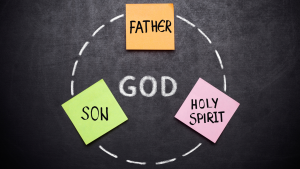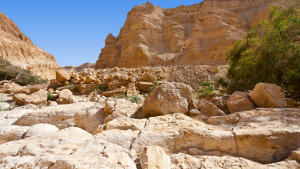Jesus Unfiltered -- Inauguration Day (Mark 1:9-13)
Published September 29, 2021
I have a confession to make.
Last time I invited you to take a trip with me. But there’s one thing I didn’t tell you. I have an ulterior motive for inviting you.
Whether you’ve spent a week on the road with extended family or gone on a short-term mission trip, one thing about traveling together is that you really get to know the people you’re with.
My motive for inviting you on this trip is just that – I hope you’ll get to know Jesus better as we travel with him through Mark’s gospel.
Today we’re going to learn more about Jesus by witnessing his baptism by John in the Jordan and his temptation by Satan in the wilderness.
You can follow along by opening your Bible to Mark 1:9-13.

Last week we learned that traveling with Jesus begins with a U turn.
John the Baptist was sent to prepare people for Jesus’ arrival by calling them to turn around (the biblical term is repentance; a change of mind resulting in a change of direction).
Specifically, he was calling them to turn away from their stubborn self-will so they’d be ready to follow Jesus when he arrived on the scene. As we’ll see next week, if you want to follow Jesus, you must forsake your former life (1:16-20).
So, let’s pick up where we left off last week. Go back to Mark 1:7.
John the Baptist’s message was clear. It’s not about him.
After me will come one more powerful than I, whose sandals I am not worthy to stoop down and untie. I baptize you with water, but he will baptize you with the Holy Spirit (1:7-8).
Now in verse 9, Mark announces the arrival of that more powerful one.
JESUS IS BAPTIZED BY JOHN IN THE JORDAN (1:9-11)

At that time Jesus came from Nazareth in Galilee and was baptized by John in the Jordan (9).
My wife, Teresa, and I once lived in a small Wisconsin town called Waldo. Do you know where it is? Didn’t think so. But that name may sound familiar.
If so, it’s probably because of the children’s book series, “Where’s Waldo?” If you’ve seen the books, you know what I’m talking about. On each page, you’re challenged to find a guy with googly glasses and a bright red & white striped shirt and hat named Waldo hidden in obscure places in the picture.

What you need to understand is that many of Mark’s Gentile readers were wondering, where’s Nazareth?
It was a backwater, nowhere-ville place. Maybe that’s why Mark felt the need to explain that Nazareth is in Galilee. What a sharp contrast with the sophisticated people of Jerusalem – the City of Zion.
Notice how the emphasis shifts here - from John to Jesus. The focus shifts from the many from Jerusalem and Judea to the one from Galilee.
Mark deliberately does this by saying, Jesus…was baptized by John (not, John baptized Jesus). Jesus’ baptism conveys his identification with sinners and confirms his divine authority.
Identification with Sinners
Imagine John’s reaction when he realized who was stepping into the water requesting baptism.
Undoubtedly, John learned all about the Messiah from his parents, Zacharias & Elizabeth. From infancy, John understood that he was to be the Messiah’s forerunner. He also knew that Mary’s son, Jesus, was the Son of God, the promised deliverer. But there is no evidence in Scripture that the two had ever met. I’m not sure what tipped him off that day, but once he realized it was Jesus, he balked at baptizing him. Mark doesn’t mention it, but Matthew tells us John tried to deter him, saying, ‘I need to be baptized by you, and do you come to me?’ (Matt 3:14).
But Jesus insisted, so John consented and baptized him.
But if Jesus was the Son of God, as Mark portrays him to be, surely he had no sin to confess or turn away from. He was sinless, so why was he baptized?
One of the primary reasons was to identify with us!
Jesus wasn’t baptized for his sins – he had none.
He was baptized because of your sins and mine.
That’s why this is also about his mission. He didn’t come to Lord it over us, but to identify with us and give his life a ransom for us (Mark 10:45). Later, Jesus referred to his death on the cross as his baptism (Mark 10:38; Luke 12:50). His baptism was a demonstration of his fitness and commitment to follow through on his mission – to seek and save the lost by dying on the cross and rising again.
Like Moses who gave up his royal status to identify with his people and to deliver them, Jesus humbled himself by identifying with the ranks of sinners and later by dying for them to pay for their sins.
But there’s more here.
Three amazing things happen as Jesus is coming up out of the water. Two are visual and one is audible.
All three testify to Jesus’ divine authentication. All three authenticate Jesus’ identity as the Son of God who came to take away the sins of the world.
The Tearing Open of Heaven

As Jesus was coming up out of the water, he saw heaven being torn open… (10a).
This was not some kind of mystical vision or inner impression he had.
This was an objective, experiential reality occurring right before his eyes: heaven was being torn open (present tense), being split apart like a garment.
God literally tore open the heavens at that very moment.
Mark uses the same verb to describe what happened to the temple curtain at the moment Jesus died on the cross.
With a loud cry, Jesus breathed his last. The curtain of the temple was torn in two from top to bottom (Mark 15:37-38).
Tearing open the heavens at Jesus’ baptism points to his mission – to tear down the dividing wall between sinful man and a holy God by removing our sin through his death on the cross. With the heavens and the temple curtain both torn open, Jesus is now the One who stands in the gap between God and man.
The Descending of the Holy Spirit

…and the Spirit descending on him like a dove (10b).
This is the second thing they saw.
Notice Mark didn’t say the Spirit was a dove; he was like a dove. Does that mean the Spirit looked like a dove, or that the Spirit’s descent was like a dove? We’re not sure. But it is clear that he saw this happen, whatever it looked like.
John saw it too and later testified (John 1:32-34) to it. Then John gave this testimony: ‘I saw the Spirit come down from heaven as a dove and remain on him… I have seen and I testify that this is the Son of God’ (John 1:32, 34).
Wasn’t Jesus conceived of the Spirit (Luke 1:35)? Didn’t he already have the Holy Spirit? Of course he did.
Clearly, this signifies the Spirit’s affirmation of Jesus’ identity. I also believe it serves as a pattern for believers; not that we receive the Spirit at water baptism, but that we need the Spirit’s empowerment to carry out our mission to represent Jesus and advance the gospel, just as Jesus needed the Spirit to enable him to fill the office of Mediator between God and man.
When Jesus later entered the temple in his hometown of Nazareth, he read from Isaiah 61:1-2 – The Spirit of the Lord is on me, because he has anointed me to preach good news to the poor. He has sent me to proclaim freedom for the prisoners and recovery of sight for the blind, to release the oppressed to proclaim the year of the Lord’s favor (Luke 6:18-19). He was empowered and commissioned for ministry by the Spirit he saw descend that day. But he also heard something, a voice from heaven.
The Thundering of Divine Approval

And a voice came from heaven: ‘You are my Son, whom I love; with you I am well pleased’ (11).
Mark doesn’t identify the voice, but he doesn’t have to.
It is the voice of God.
He calls Jesus my Son. This is another strong affirmation of the deity of Christ.
There’s something here I don’t want you to miss.
Here, at Jesus’ baptism, we have a beautiful Trinitarian exchange. God the Father speaks from heaven as God the Holy Spirit descends upon God the Son. All three persons of the Godhead are involved in this unmistakable identification of Jesus as the Son of God.

John baptized a lot of people. But I’m sure nothing prepared him for what took place when he plunged Jesus into the river that day. As Jesus came up out of the water, drying his eyes and regaining his footing, all heaven broke loose!
That miraculous baptism signaled the beginning of Jesus’ public ministry (Acts 1:21-22), confirmed his identity as God’s Son, and pointed forward to the cross.
If you’ve been baptized or attended a baptism service, you know how special the experience is. I still remember when I was baptized as a teenager. Maybe you remember yours too. It’s such a spiritual high.
If that’s the normal baptism experience, just imagine how thrilling Jesus’ baptism must’ve been. It was a turning point. His silent years (childhood and youth) are over. The Spirit is now on him and he’s ready to go preach good news to the poor and proclaim freedom to prisoners. Now it’s time to celebrate!
Given such a glorious baptism, you might expect a glorious celebration with angelic singing and doxologies.
Instead, the Spirit leads him straight from baptism out into the wilderness to face Satan.
JESUS IS TEMPTED BY SATAN IN THE WILDERNESS (1:12-13)

At once the Spirit sent him into the desert, and he was in the desert forty days, being tempted by Satan. He was with the wild animals, and angels attended him (1:12-13).
Mark doesn’t even give us a chance to catch our breath. It’s like he’s still wet as he walks out into the wilderness. What a contrast!
Immediately after hearing the accolades of heaven, Jesus faces the fury of hell.
That’s a picture of life, though, isn’t it? Life’s full of ups and downs, highs and lows. One day you’re beaming in the sunshine on top of the mountain, the next day you’re fighting doubts and discouragement in a dark valley. Sometimes it all happens on the same day!
It can be easy to lose sight of what God is doing in our lives in the midst of our ever-changing circumstances. That’s why Mark’s message here is so helpful.
John, you remember, was preaching in a remote location (1:4), but it was at least accessible to crowds of people. Where the Spirit takes Jesus now, however, is completely isolated and utterly desolate. John MacArthur describes the Judean wilderness.
The Judean wilderness is an arid, inhospitable desert that stretches west from the Dead Sea toward Jerusalem, encompassing an area roughly thirty-five miles long and fifteen miles wide. The dusty, desolate, and dangerous landscape is broken up by rocky peaks, craggy cliffs, and plunging ravines.
It’s the kind of place where wild animals roam free.
Alright, so what’s going on here? I thought the Father loved the Son and was pleased with him. Why in the world is the Spirit leading Jesus out to such a desolate place for 40 days?
First, notice the text is clear.
Jesus’ wilderness experience is not presented as some sort of unfortunate hardship caused by a misstep or failure on his part. His desert days are as divinely orchestrated as his baptism.
In addition, it’s vital to understand that although he was led out there by the Spirit, he was tempted by Satan – not by the Spirit.
God never tempts anyone, nor can he (James 1:13). Jesus was tempted by Satan – God’s personal and supernatural adversary who intends to subvert God’s reign as it is manifested through his Son.
So, we shouldn’t be surprised. Jesus’ mission necessarily involves squaring off with Satan. The Apostle John later said, the reason the Son of God appeared was to destroy the devil’s work (1 John 3:8).
Do you see what’s going on? Jesus (the second Adam) came to undo what Adam had done through his sin and fall. Therefore, it was in a sinful, fallen, and broken world that Jesus faced temptation and the powers of darkness, in order to provide for us a way back to the Tree of Life.
Although Mark doesn’t report the outcome of Jesus’ clash with Satan, his concluding phrase, and angels attended him (1:13) implies what the other gospel writers’ state explicitly, that Jesus triumphed over all the temptation Satan threw at him. And he continued to overpower Satan and his demons throughout his entire ministry, as we’ll discover as we move through Mark’s gospel.
As we wind down today’s journey, let’s take a few minutes to reflect on what we’ve learned and try to understand how it applies to us today. Let me offer three take-aways – one is something to know and believe, and two are things to do.
Acknowledge Jesus’ True Identity & Mission
If there’s one thing Mark is trying to convey in the carefully selected opening lines of his narrative, it’s that Jesus Christ is the Son of God who came to give his life for sinners.
Jesus didn’t take on flesh in order to provide good advice on how to live a better life. He wasn’t born to help us get along or to teach us how to take care of the poor or to restore “social justice.” Those things are good, but ultimately that’s not why he came.
Go back to verse one.
The beginning of the GOSPEL of Jesus Christ, the Son of God.
He came to bring good news. He came to embody good news, the good news that God loves us and has ripped heaven open to provide a way to restore our broken relationship with him. And that way is through Jesus’ death and resurrection.
He is the Son of God who took on human form so he could bridge the gap between you and God. That’s who he is and why he came.
Do you believe that?
Are you trusting in him for your salvation today?
Are you on “mission” for him – his mission?
Are you showing and sharing the transforming love of Jesus through radical hospitality with your neighbors?
Follow Jesus into the Waters of Baptism
Have you been baptized by immersion as a believer?
Jesus didn’t have to be baptized because he had never sinned. He chose to do so in order to identify with sinners like you and me. He did it in order to identify with our sins, yours and mine.
Are you willing to stand up and be identified with him through baptism?
Walk with Jesus through the Wilderness
We have a tendency to accept the high points in our lives as ordained by God, but to see the trials and troubles as being a mistake or failure by ourselves or God. But that’s not a biblical picture. God is in control of everything that happens to us – the good and the bad.
Think of Job and all he endured, the loss of everything he held dear. All snatched away in an instant. Yet, what did Job say? Naked I came from my mother’s womb, and naked I will depart. The LORD gave and the LORD has taken away; may the name of the LORD be praised (Job 1:20, 21).
Augustine wisely observed that Job did not say, ‘The Lord gave and the devil took away,’ but, ‘the Lord gave and the Lord took away.’ It was God’s Spirit that led Jesus into the desert. And at times the Spirit leads into the wilderness too.
Maybe you find yourself there right now.
The wilderness takes many forms. Maybe you’re wandering in the wilderness of discouragement, loneliness, or clinical depression - or maybe the desert of a difficult marriage. Maybe you’re struggling right now in the wilderness of mental illness, or wayward children, perhaps same-sex attraction, financial reversals, personal betrayals, or a debilitating loss.
Here’s the thing. At times God leads us into the wilderness, but it’s always intended for our good. He’s on your side.
But here’s the problem. The devil will always try to leverage the wilderness for evil.
He’ll tempt you to doubt God’s goodness or faithfulness, ultimately to turn your heart bitter toward God. Don’t let him!
Keep trusting God’s goodness and love for you. He may seem far off, but he is with you every step of the way. So keep walking with him through to the other side.
Timothy Keller wrote an excellent book called, Walking with God through Pain and Suffering. I highly recommend it.
Keller asks, He walks with us, but the real question is – will we walk with him? If we have created a false God-of-my-program, then when life falls apart we simply assume he has abandoned us and we won’t seek him, (Walking with God through Pain & Suffering, p. 234).
Oh, dear friends, that’s why this passage is so helpful and instructive for us. It demolishes the false God-of-my-program by showing us that God’s program is to save sinners, not to make my life more comfortable. And this passage also shows us that God’s plan for us at times involves wilderness experiences.
We realize that God is on our side even in the wilderness, and that gives us the faith and hope to keep walking with him even when life is hard.
Will you keep walking with him through the wilderness this week?
Want to know more about salvation? Read this.
Are you interested in reading more about baptism? Check this resource out.
Blog post adapted from the message by the same name delivered on Sunday, September 26. Prefer to listen? You can hear the message here.
Sources used
The NIV Application Commentary, David E. Garland.
The Pillar New Testament Commentary Series: The Gospel According to Mark, James R. Edwards.
Believer’s Church Commentary: Mark, Elmer A. Martens & Willard M. Swartley, editors.
Let’s Study Mark, Sinclair B. Ferguson.
Reformed Expository Commentary: Luke, Volume 1: Chapters 1-12.
The Harmony of the Gospels, Robert L. Thomas and Stanley N. Gundry.
Last time I invited you to take a trip with me. But there’s one thing I didn’t tell you. I have an ulterior motive for inviting you.
Whether you’ve spent a week on the road with extended family or gone on a short-term mission trip, one thing about traveling together is that you really get to know the people you’re with.
My motive for inviting you on this trip is just that – I hope you’ll get to know Jesus better as we travel with him through Mark’s gospel.
Today we’re going to learn more about Jesus by witnessing his baptism by John in the Jordan and his temptation by Satan in the wilderness.
You can follow along by opening your Bible to Mark 1:9-13.

Last week we learned that traveling with Jesus begins with a U turn.
John the Baptist was sent to prepare people for Jesus’ arrival by calling them to turn around (the biblical term is repentance; a change of mind resulting in a change of direction).
Specifically, he was calling them to turn away from their stubborn self-will so they’d be ready to follow Jesus when he arrived on the scene. As we’ll see next week, if you want to follow Jesus, you must forsake your former life (1:16-20).
So, let’s pick up where we left off last week. Go back to Mark 1:7.
John the Baptist’s message was clear. It’s not about him.
After me will come one more powerful than I, whose sandals I am not worthy to stoop down and untie. I baptize you with water, but he will baptize you with the Holy Spirit (1:7-8).
Now in verse 9, Mark announces the arrival of that more powerful one.
JESUS IS BAPTIZED BY JOHN IN THE JORDAN (1:9-11)

At that time Jesus came from Nazareth in Galilee and was baptized by John in the Jordan (9).
My wife, Teresa, and I once lived in a small Wisconsin town called Waldo. Do you know where it is? Didn’t think so. But that name may sound familiar.
If so, it’s probably because of the children’s book series, “Where’s Waldo?” If you’ve seen the books, you know what I’m talking about. On each page, you’re challenged to find a guy with googly glasses and a bright red & white striped shirt and hat named Waldo hidden in obscure places in the picture.

What you need to understand is that many of Mark’s Gentile readers were wondering, where’s Nazareth?
It was a backwater, nowhere-ville place. Maybe that’s why Mark felt the need to explain that Nazareth is in Galilee. What a sharp contrast with the sophisticated people of Jerusalem – the City of Zion.
Notice how the emphasis shifts here - from John to Jesus. The focus shifts from the many from Jerusalem and Judea to the one from Galilee.
Mark deliberately does this by saying, Jesus…was baptized by John (not, John baptized Jesus). Jesus’ baptism conveys his identification with sinners and confirms his divine authority.
Identification with Sinners
Imagine John’s reaction when he realized who was stepping into the water requesting baptism.
Undoubtedly, John learned all about the Messiah from his parents, Zacharias & Elizabeth. From infancy, John understood that he was to be the Messiah’s forerunner. He also knew that Mary’s son, Jesus, was the Son of God, the promised deliverer. But there is no evidence in Scripture that the two had ever met. I’m not sure what tipped him off that day, but once he realized it was Jesus, he balked at baptizing him. Mark doesn’t mention it, but Matthew tells us John tried to deter him, saying, ‘I need to be baptized by you, and do you come to me?’ (Matt 3:14).
But Jesus insisted, so John consented and baptized him.
But if Jesus was the Son of God, as Mark portrays him to be, surely he had no sin to confess or turn away from. He was sinless, so why was he baptized?
One of the primary reasons was to identify with us!
Jesus wasn’t baptized for his sins – he had none.
He was baptized because of your sins and mine.
That’s why this is also about his mission. He didn’t come to Lord it over us, but to identify with us and give his life a ransom for us (Mark 10:45). Later, Jesus referred to his death on the cross as his baptism (Mark 10:38; Luke 12:50). His baptism was a demonstration of his fitness and commitment to follow through on his mission – to seek and save the lost by dying on the cross and rising again.
Like Moses who gave up his royal status to identify with his people and to deliver them, Jesus humbled himself by identifying with the ranks of sinners and later by dying for them to pay for their sins.
But there’s more here.
Three amazing things happen as Jesus is coming up out of the water. Two are visual and one is audible.
All three testify to Jesus’ divine authentication. All three authenticate Jesus’ identity as the Son of God who came to take away the sins of the world.
The Tearing Open of Heaven

As Jesus was coming up out of the water, he saw heaven being torn open… (10a).
This was not some kind of mystical vision or inner impression he had.
This was an objective, experiential reality occurring right before his eyes: heaven was being torn open (present tense), being split apart like a garment.
God literally tore open the heavens at that very moment.
Mark uses the same verb to describe what happened to the temple curtain at the moment Jesus died on the cross.
With a loud cry, Jesus breathed his last. The curtain of the temple was torn in two from top to bottom (Mark 15:37-38).
Tearing open the heavens at Jesus’ baptism points to his mission – to tear down the dividing wall between sinful man and a holy God by removing our sin through his death on the cross. With the heavens and the temple curtain both torn open, Jesus is now the One who stands in the gap between God and man.
The Descending of the Holy Spirit

…and the Spirit descending on him like a dove (10b).
This is the second thing they saw.
Notice Mark didn’t say the Spirit was a dove; he was like a dove. Does that mean the Spirit looked like a dove, or that the Spirit’s descent was like a dove? We’re not sure. But it is clear that he saw this happen, whatever it looked like.
John saw it too and later testified (John 1:32-34) to it. Then John gave this testimony: ‘I saw the Spirit come down from heaven as a dove and remain on him… I have seen and I testify that this is the Son of God’ (John 1:32, 34).
Wasn’t Jesus conceived of the Spirit (Luke 1:35)? Didn’t he already have the Holy Spirit? Of course he did.
Clearly, this signifies the Spirit’s affirmation of Jesus’ identity. I also believe it serves as a pattern for believers; not that we receive the Spirit at water baptism, but that we need the Spirit’s empowerment to carry out our mission to represent Jesus and advance the gospel, just as Jesus needed the Spirit to enable him to fill the office of Mediator between God and man.
When Jesus later entered the temple in his hometown of Nazareth, he read from Isaiah 61:1-2 – The Spirit of the Lord is on me, because he has anointed me to preach good news to the poor. He has sent me to proclaim freedom for the prisoners and recovery of sight for the blind, to release the oppressed to proclaim the year of the Lord’s favor (Luke 6:18-19). He was empowered and commissioned for ministry by the Spirit he saw descend that day. But he also heard something, a voice from heaven.
The Thundering of Divine Approval

And a voice came from heaven: ‘You are my Son, whom I love; with you I am well pleased’ (11).
Mark doesn’t identify the voice, but he doesn’t have to.
It is the voice of God.
He calls Jesus my Son. This is another strong affirmation of the deity of Christ.
There’s something here I don’t want you to miss.
Here, at Jesus’ baptism, we have a beautiful Trinitarian exchange. God the Father speaks from heaven as God the Holy Spirit descends upon God the Son. All three persons of the Godhead are involved in this unmistakable identification of Jesus as the Son of God.

John baptized a lot of people. But I’m sure nothing prepared him for what took place when he plunged Jesus into the river that day. As Jesus came up out of the water, drying his eyes and regaining his footing, all heaven broke loose!
That miraculous baptism signaled the beginning of Jesus’ public ministry (Acts 1:21-22), confirmed his identity as God’s Son, and pointed forward to the cross.
If you’ve been baptized or attended a baptism service, you know how special the experience is. I still remember when I was baptized as a teenager. Maybe you remember yours too. It’s such a spiritual high.
If that’s the normal baptism experience, just imagine how thrilling Jesus’ baptism must’ve been. It was a turning point. His silent years (childhood and youth) are over. The Spirit is now on him and he’s ready to go preach good news to the poor and proclaim freedom to prisoners. Now it’s time to celebrate!
Given such a glorious baptism, you might expect a glorious celebration with angelic singing and doxologies.
Instead, the Spirit leads him straight from baptism out into the wilderness to face Satan.
JESUS IS TEMPTED BY SATAN IN THE WILDERNESS (1:12-13)

At once the Spirit sent him into the desert, and he was in the desert forty days, being tempted by Satan. He was with the wild animals, and angels attended him (1:12-13).
Mark doesn’t even give us a chance to catch our breath. It’s like he’s still wet as he walks out into the wilderness. What a contrast!
Immediately after hearing the accolades of heaven, Jesus faces the fury of hell.
That’s a picture of life, though, isn’t it? Life’s full of ups and downs, highs and lows. One day you’re beaming in the sunshine on top of the mountain, the next day you’re fighting doubts and discouragement in a dark valley. Sometimes it all happens on the same day!
It can be easy to lose sight of what God is doing in our lives in the midst of our ever-changing circumstances. That’s why Mark’s message here is so helpful.
John, you remember, was preaching in a remote location (1:4), but it was at least accessible to crowds of people. Where the Spirit takes Jesus now, however, is completely isolated and utterly desolate. John MacArthur describes the Judean wilderness.
The Judean wilderness is an arid, inhospitable desert that stretches west from the Dead Sea toward Jerusalem, encompassing an area roughly thirty-five miles long and fifteen miles wide. The dusty, desolate, and dangerous landscape is broken up by rocky peaks, craggy cliffs, and plunging ravines.
It’s the kind of place where wild animals roam free.
Alright, so what’s going on here? I thought the Father loved the Son and was pleased with him. Why in the world is the Spirit leading Jesus out to such a desolate place for 40 days?
First, notice the text is clear.
Jesus’ wilderness experience is not presented as some sort of unfortunate hardship caused by a misstep or failure on his part. His desert days are as divinely orchestrated as his baptism.
In addition, it’s vital to understand that although he was led out there by the Spirit, he was tempted by Satan – not by the Spirit.
God never tempts anyone, nor can he (James 1:13). Jesus was tempted by Satan – God’s personal and supernatural adversary who intends to subvert God’s reign as it is manifested through his Son.
So, we shouldn’t be surprised. Jesus’ mission necessarily involves squaring off with Satan. The Apostle John later said, the reason the Son of God appeared was to destroy the devil’s work (1 John 3:8).
Do you see what’s going on? Jesus (the second Adam) came to undo what Adam had done through his sin and fall. Therefore, it was in a sinful, fallen, and broken world that Jesus faced temptation and the powers of darkness, in order to provide for us a way back to the Tree of Life.
Although Mark doesn’t report the outcome of Jesus’ clash with Satan, his concluding phrase, and angels attended him (1:13) implies what the other gospel writers’ state explicitly, that Jesus triumphed over all the temptation Satan threw at him. And he continued to overpower Satan and his demons throughout his entire ministry, as we’ll discover as we move through Mark’s gospel.
As we wind down today’s journey, let’s take a few minutes to reflect on what we’ve learned and try to understand how it applies to us today. Let me offer three take-aways – one is something to know and believe, and two are things to do.
Acknowledge Jesus’ True Identity & Mission
If there’s one thing Mark is trying to convey in the carefully selected opening lines of his narrative, it’s that Jesus Christ is the Son of God who came to give his life for sinners.
Jesus didn’t take on flesh in order to provide good advice on how to live a better life. He wasn’t born to help us get along or to teach us how to take care of the poor or to restore “social justice.” Those things are good, but ultimately that’s not why he came.
Go back to verse one.
The beginning of the GOSPEL of Jesus Christ, the Son of God.
He came to bring good news. He came to embody good news, the good news that God loves us and has ripped heaven open to provide a way to restore our broken relationship with him. And that way is through Jesus’ death and resurrection.
He is the Son of God who took on human form so he could bridge the gap between you and God. That’s who he is and why he came.
Do you believe that?
Are you trusting in him for your salvation today?
Are you on “mission” for him – his mission?
Are you showing and sharing the transforming love of Jesus through radical hospitality with your neighbors?
Follow Jesus into the Waters of Baptism
Have you been baptized by immersion as a believer?
Jesus didn’t have to be baptized because he had never sinned. He chose to do so in order to identify with sinners like you and me. He did it in order to identify with our sins, yours and mine.
Are you willing to stand up and be identified with him through baptism?
Walk with Jesus through the Wilderness
We have a tendency to accept the high points in our lives as ordained by God, but to see the trials and troubles as being a mistake or failure by ourselves or God. But that’s not a biblical picture. God is in control of everything that happens to us – the good and the bad.
Think of Job and all he endured, the loss of everything he held dear. All snatched away in an instant. Yet, what did Job say? Naked I came from my mother’s womb, and naked I will depart. The LORD gave and the LORD has taken away; may the name of the LORD be praised (Job 1:20, 21).
Augustine wisely observed that Job did not say, ‘The Lord gave and the devil took away,’ but, ‘the Lord gave and the Lord took away.’ It was God’s Spirit that led Jesus into the desert. And at times the Spirit leads into the wilderness too.
Maybe you find yourself there right now.
The wilderness takes many forms. Maybe you’re wandering in the wilderness of discouragement, loneliness, or clinical depression - or maybe the desert of a difficult marriage. Maybe you’re struggling right now in the wilderness of mental illness, or wayward children, perhaps same-sex attraction, financial reversals, personal betrayals, or a debilitating loss.
Here’s the thing. At times God leads us into the wilderness, but it’s always intended for our good. He’s on your side.
But here’s the problem. The devil will always try to leverage the wilderness for evil.
He’ll tempt you to doubt God’s goodness or faithfulness, ultimately to turn your heart bitter toward God. Don’t let him!
Keep trusting God’s goodness and love for you. He may seem far off, but he is with you every step of the way. So keep walking with him through to the other side.
Timothy Keller wrote an excellent book called, Walking with God through Pain and Suffering. I highly recommend it.
Keller asks, He walks with us, but the real question is – will we walk with him? If we have created a false God-of-my-program, then when life falls apart we simply assume he has abandoned us and we won’t seek him, (Walking with God through Pain & Suffering, p. 234).
Oh, dear friends, that’s why this passage is so helpful and instructive for us. It demolishes the false God-of-my-program by showing us that God’s program is to save sinners, not to make my life more comfortable. And this passage also shows us that God’s plan for us at times involves wilderness experiences.
We realize that God is on our side even in the wilderness, and that gives us the faith and hope to keep walking with him even when life is hard.
Will you keep walking with him through the wilderness this week?
Want to know more about salvation? Read this.
Are you interested in reading more about baptism? Check this resource out.
Blog post adapted from the message by the same name delivered on Sunday, September 26. Prefer to listen? You can hear the message here.
Sources used
The NIV Application Commentary, David E. Garland.
The Pillar New Testament Commentary Series: The Gospel According to Mark, James R. Edwards.
Believer’s Church Commentary: Mark, Elmer A. Martens & Willard M. Swartley, editors.
Let’s Study Mark, Sinclair B. Ferguson.
Reformed Expository Commentary: Luke, Volume 1: Chapters 1-12.
The Harmony of the Gospels, Robert L. Thomas and Stanley N. Gundry.
